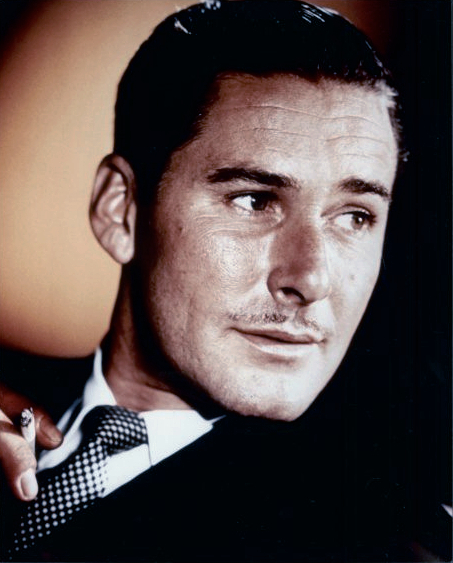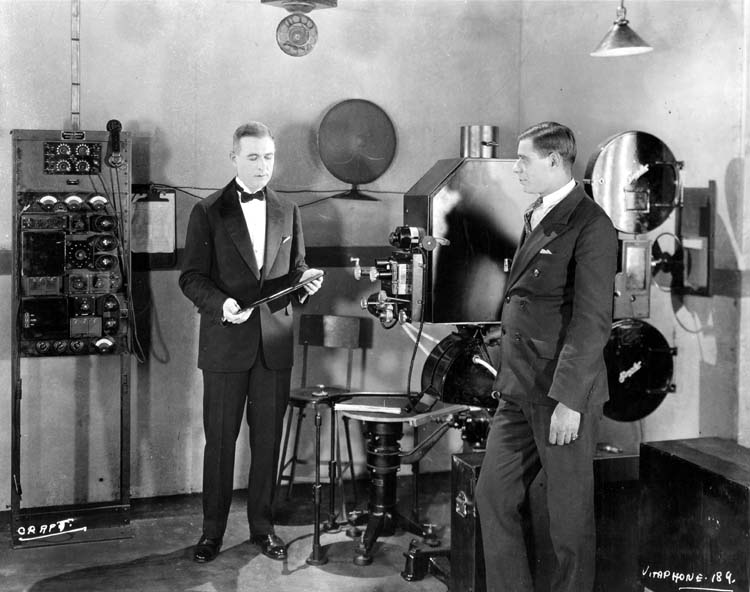|
Film Tinting
Film tinting is the process of adding color to black-and-white film, usually by means of soaking the film in dye and staining the film emulsion. The effect is that all of the light shining through is filtered, so that what would be white light becomes light of some color. Film toning is the process of replacing the silver particles in the emulsion with colored, silver salts, by means of chemicals. Unlike tinting, toning colored the darkest areas, leaving the white areas largely untouched. History Tinting in the silent era The process began in the 1890s, originally as a copy-guard against film pirates. The film was tinted amber, the color of the safelight on film printers. The discovery of bleaching methods by pirates soon put an end to this. Both the Edison Studios and the Biograph Company began tinting their films for setting moods. Because orthochromatic film stock could not be used in low-light situations, blue became the most popular tint, applied to scenes shot during the d ... [...More Info...] [...Related Items...] OR: [Wikipedia] [Google] [Baidu] |
Photographic Emulsion
Photographic emulsion is a light-sensitive colloid used in film-based photography. Most commonly, in silver-gelatin photography, it consists of silver halide crystals dispersed in gelatin. The emulsion is usually coated onto a substrate of glass, films (of cellulose nitrate, cellulose acetate or polyester), paper, or fabric. Photographic emulsion is not a true emulsion, but a suspension of solid particles (silver halide) in a fluid (gelatin in solution). However, the word ''emulsion'' is customarily used in a photographic context. Gelatin or gum arabic layers sensitized with dichromate used in the dichromated colloid processes carbon and gum bichromate are sometimes called ''emulsions''. Some processes do not have emulsions, such as platinum, cyanotype, salted paper, or kallitype. Components Photographic emulsion is a fine suspension of insoluble light-sensitive crystals in a colloid sol, usually consisting of gelatin. The light-sensitive component is one or a mixture o ... [...More Info...] [...Related Items...] OR: [Wikipedia] [Google] [Baidu] |
The Sea Hawk (1940 Film)
''The Sea Hawk'' is a 1940 American adventure film from Warner Bros. that stars Errol Flynn as an English privateer who defends his nation's interests on the eve of the launch of the Spanish Armada. The film was the tenth collaboration between Flynn and director Michael Curtiz. Its screenplay was written by Howard Koch and Seton I. Miller. The rousing musical score by Erich Wolfgang Korngold is recognized as a high point in his career. The film was both an adventure and a period piece about Elizabethan England's struggles with Spain. It was also meant as a deliberately pro-British propaganda film to build morale during World War II and to influence the American public into having a more pro-British outlook. King Philip was presented as an allegorical Hitler. (The same theme had been visited in Alexander Korda's film ''Fire Over England'', released three years earlier, before World War II started). Colorized versions of ''The Sea Hawk'' were broadcast on American television and ... [...More Info...] [...Related Items...] OR: [Wikipedia] [Google] [Baidu] |
Warner Brothers
Warner Bros. Entertainment Inc. (commonly known as Warner Bros. or abbreviated as WB) is an American Film studio, film and entertainment studio headquartered at the Warner Bros. Studios, Burbank, Warner Bros. Studios complex in Burbank, California, Burbank, California, and a subsidiary of Warner Bros. Discovery. Founded in 1923 by four brothers, Harry Warner, Harry, Albert Warner, Albert, Sam Warner, Sam, and Jack L. Warner, Jack Warner, the company established itself as a leader in the American Warner Bros. Pictures, film industry before diversifying into Warner Bros. Animation, animation, Warner Bros. Television Studios, television, and Warner Bros. Interactive Entertainment, video games and is one of the Major film studio, "Big Five" major American film studios, as well as a member of the Motion Picture Association (MPA). The company is known for its film studio division the Warner Bros. Pictures Group, which includes Warner Bros. Pictures, New Line Cinema, the Warner Animat ... [...More Info...] [...Related Items...] OR: [Wikipedia] [Google] [Baidu] |
The Wizard Of Oz (1939 Film)
''The Wizard of Oz'' is a 1939 American Musical film, musical fantasy film produced by Metro-Goldwyn-Mayer (MGM). An adaptation of L. Frank Baum's 1900 children's fantasy novel ''The Wonderful Wizard of Oz'', the film was primarily directed by Victor Fleming (who left the production to take over the troubled ''Gone with the Wind (film), Gone with the Wind''), and stars Judy Garland, Frank Morgan, Ray Bolger, Bert Lahr, Jack Haley, Billie Burke and Margaret Hamilton (actress), Margaret Hamilton. Noel Langley, Florence Ryerson, and Edgar Allan Woolf received credit for the screenplay, but others made uncredited contributions. The music was composed by Harold Arlen and adapted by Herbert Stothart, with the lyrics written by Yip Harburg, Edgar "Yip" Harburg. Characterized by its use of Technicolor, fantasy storytelling, musical score, and memorable characters, the film was considered a critical success and was nominated for six Academy Awards, including Academy Award for Best Pictur ... [...More Info...] [...Related Items...] OR: [Wikipedia] [Google] [Baidu] |
Snipe (theatrical)
A snipe in the motion picture exhibition business refers to a few things: * Any material before the feature presentation other than a trailer. "Welcome to our theater," courtesy trailers ("no smoking, littering, talking"), promotions for the snackbar, and "daters", that announce the date for an upcoming show, are the most common kinds of snipes. * A printed sticker or material that is made for the purpose of being pasted over other print material, such as posters or souvenir programs, in order to alter or add to information. * In a rare type, sometimes snipes do local events, places or merchants while music tracks play during intermissions. See also * Snipe (graphic), or Promo * ''Let's All Go to the Lobby ''Let's All Go to the Lobby'' (officially known as ''Technicolor Refreshment Trailer No. 1'') is a 1957 animated musical advertisement played in theaters before the beginning of the main film or before intermission, featuring animated food items ...'' References Fi ... [...More Info...] [...Related Items...] OR: [Wikipedia] [Google] [Baidu] |
Synchronization
Synchronization is the coordination of events to operate a system in unison. For example, the conductor of an orchestra keeps the orchestra synchronized or ''in time''. Systems that operate with all parts in synchrony are said to be synchronous or ''in sync''—and those that are not are '' asynchronous''. Today, time synchronization can occur between systems around the world through satellite navigation signals and other time and frequency transfer techniques. Navigation and railways Time-keeping and synchronization of clocks is a critical problem in long-distance ocean navigation. Before radio navigation and satellite-based navigation, navigators required accurate time in conjunction with astronomical observations to determine how far east or west their vessel traveled. The invention of an accurate marine chronometer revolutionized marine navigation. By the end of the 19th century, important ports provided time signals in the form of a signal gun, flag, or dropping time ... [...More Info...] [...Related Items...] OR: [Wikipedia] [Google] [Baidu] |
Vitaphone
Vitaphone was a sound film system used for feature films and nearly 1,000 short subjects made by Warner Bros. and its sister studio First National from 1926 to 1931. Vitaphone was the last major analog sound-on-disc system and the only one that was widely used and commercially successful. The soundtrack was not printed on the film itself, but issued separately on phonograph records. The discs, recorded at rpm (a speed first used for this system) and typically in diameter, would be played on a turntable physically coupled to the projector motor while the film was being projected. It had a frequency response of 4300 Hz. Many early talkies, such as ''The Jazz Singer'' (1927), used the Vitaphone system. The name "Vitaphone" derived from the Latin and Greek words, respectively, for "living" and "sound". The "Vitaphone" trademark was later associated with cartoons and other short subjects that had optical soundtracks and did not use discs. Early history In the early 19 ... [...More Info...] [...Related Items...] OR: [Wikipedia] [Google] [Baidu] |
Sonochrome
Sonochrome was a brand of Kodak film stock that was pre-tinted, but did not interfere with the optical soundtrack on the film. It was introduced in 1928 and was discontinued in the 1970s. Sonochrome stocks did not see much use in features after the 1930s, but were widely used in theater snipes (short advertisements) and special scenes in films. Colors available There were 17 colors in the Sonochrome spectrum: *Rose Doree *Peachblow *Afterglow *Firelight *Candleflame *Sunshine *Verdante *Aquagreen *Turquoise *Azure *Nocturne *Purplehaze *Fleur de lis *Amaranth *Caprice *Inferno References * http://zauberklang.ch/filmcolors/timeline-entry/1330/ See also *Film tinting *Film colorization Film colorization (American English; or colourisation [British English], or colourization [Canadian English and Oxford English]) is any process that adds color to black-and-white, sepia, or other monochrome moving-picture imag ... Film and video technology {{film ... [...More Info...] [...Related Items...] OR: [Wikipedia] [Google] [Baidu] |
Sound-on-film
Sound-on-film is a class of sound film processes where the sound accompanying a picture is recorded on photographic film, usually, but not always, the same strip of film carrying the picture. Sound-on-film processes can either record an analog sound track or digital sound track, and may record the signal either optically or magnetically. Earlier technologies were sound-on-disc, meaning the film's soundtrack would be on a separate phonograph record. History Sound on film can be dated back to the early 1880s, when Charles E. Fritts filed a patent claiming the idea. In 1923 a patent was filed by E. E. Ries, for a variable density soundtrack recording, which was submitted to the SMPE (now SMPTE), which used the mercury vapor lamp as a modulating device to create a variable-density soundtrack. Later, Case Laboratories and Lee De Forest attempted to commercialize this process, when they developed an Aeolite glow lamp, which was deployed at Movietone Newsreel at the Roxy Theatre ... [...More Info...] [...Related Items...] OR: [Wikipedia] [Google] [Baidu] |
Color Film
Color photography is photography that uses media capable of capturing and reproducing colors. By contrast, black-and-white or gray-monochrome photography records only a single channel of luminance (brightness) and uses media capable only of showing shades of gray. In color photography, electronic sensors or light-sensitive chemicals record color information at the time of exposure. This is usually done by analyzing the spectrum of colors into three channels of information, one dominated by red, another by green and the third by blue, in imitation of the way the normal human eye senses color. The recorded information is then used to reproduce the original colors by mixing various proportions of red, green and blue light ( RGB color, used by video displays, digital projectors and some historical photographic processes), or by using dyes or pigments to remove various proportions of the red, green and blue which are present in white light ( CMY color, used for prints on paper an ... [...More Info...] [...Related Items...] OR: [Wikipedia] [Google] [Baidu] |
Panchromatic
Panchromatic emulsion is a type of black-and-white photographic emulsion that is sensitive to all wavelengths of visible light. Description A panchromatic emulsion renders a realistic reproduction of a scene as it appears to the human eye, although with no colors. Almost all modern photographic film is panchromatic. Some older types of film were orthochromatic and were not sensitive to certain wavelengths of light. As naturally prepared, a silver halide photographic emulsion is much more sensitive to blue and UV light than to green and red wavelengths. The German chemist Hermann W. Vogel found out how to extend the sensitivity into the green, and later the orange, by adding sensitising dyes to the emulsion. By the addition of erythrosine the emulsion could be made orthochromatic while some cyanine derivatives confer sensitivity to the whole visible spectrum making it panchromatic. However, his technique was not extended to achieve a fully panchromatic film until the early 190 ... [...More Info...] [...Related Items...] OR: [Wikipedia] [Google] [Baidu] |







